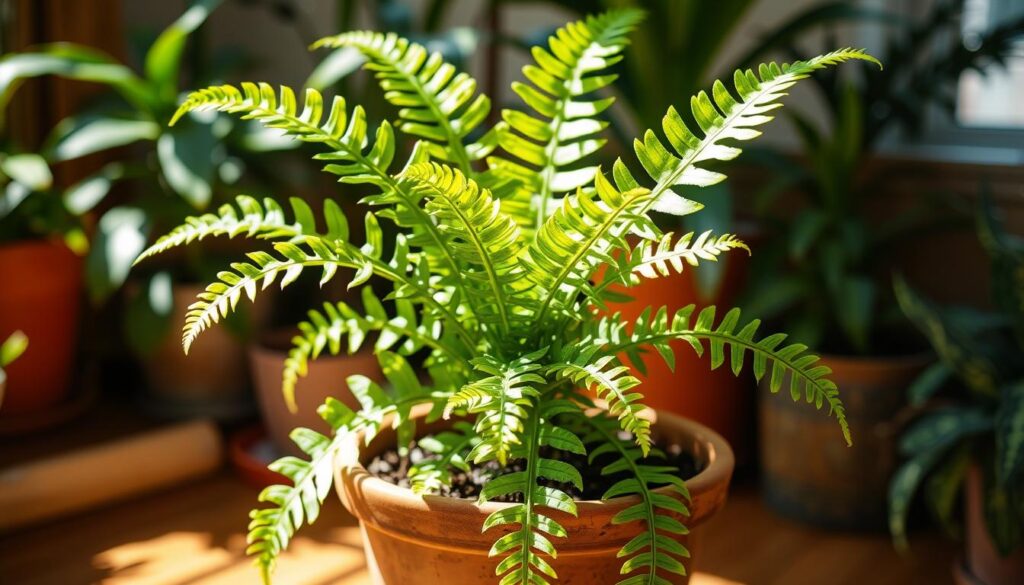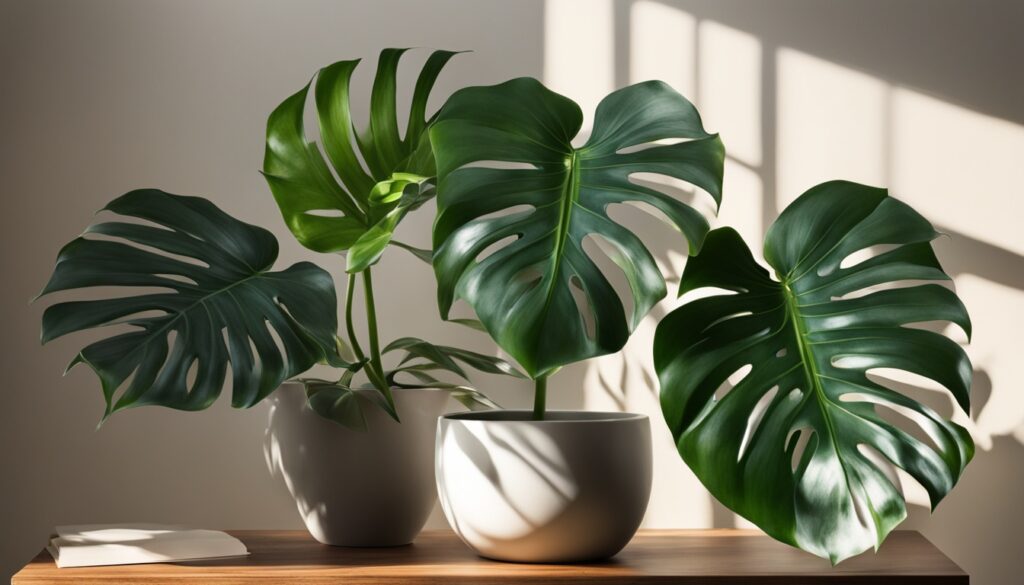Are you drawn to the staghorn fern’s unique look? These tropical plants grow on other plants or objects. They’re perfect for indoor and outdoor spaces. But, did you know you can grow a potted staghorn fern at home? This guide will show you how to care for a stunning staghorn fern.
Key Takeaways
- Staghorn ferns are epiphytic plants that can be grown in pots or mounted on surfaces
- They require bright, indirect light, consistent moisture, and high humidity to thrive
- Proper watering, fertilizing, and potting mix are crucial for healthy growth
- Potential challenges include low light, overwatering, and pest infestations
- With the right care, staghorn ferns can grow to impressive sizes and become stunning focal points
Whether you’re new to plants or experienced, this guide is for you. Learn how to care for a potted staghorn fern that will impress everyone. Let’s explore the world of these unique, tropical plants together.
Introduction
Staghorn ferns, also known as elkhorn ferns, come from the Polypodiaceae family. They are found in tropical Asia and Oceania. These epiphytic plants use other plants or objects for support, but they don’t harm them. They have two types of leaves: small, flat fronds that protect the roots, and large, antler-like fronds that stick out.
Overview of Potted Staghorn Fern Care
Caring for a potted staghorn fern means knowing what it needs. They love warm, humid places and bright, indirect light. They need water often to stay moist, but the soil should dry a bit between waterings. This way, they stay healthy and look great indoors.
“Staghorn ferns consist of about 18 species of epiphytic ferns native primarily to Africa, Australia, and Southeast Asia.”
These plants are easy to show off in many ways. You can mount them on wood, grow them in moss-lined baskets, or make kokedama displays. Their unique leaves and ability to adapt make them a favorite among plant lovers.
Potted Staghorn Fern Traits
Staghorn ferns have two kinds of leaves: shield fronds and antler fronds. The shield fronds are small and flat, protecting the roots. The antler fronds are larger, green, and pronged, looking like deer or elk antlers.
These unique tropical ferns come from warm, humid places. They grow on trees or other plants, getting moisture and nutrients from the air, not soil.
Antler and Shield Fronds
The antler fronds are the standout feature, branching out like animal horns. They do photosynthesis and grow the plant. The shield fronds, on the other hand, are smaller and flat. They protect the roots and help absorb moisture and nutrients.
Native to Tropical Regions
Staghorn ferns come from South America, Africa, and Australasia. They live on tree bark, using shield fronds to cling and antler fronds to catch moisture and sunlight. This way, they’re perfect for potted plants in warm, humid places.
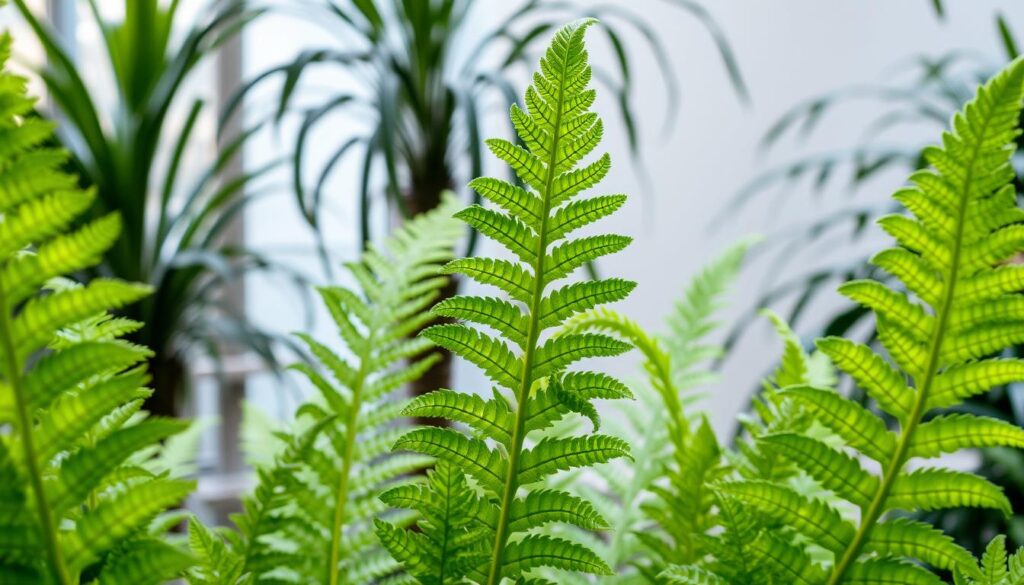
| Staghorn Fern Species | Origin | Characteristics |
|---|---|---|
| Platycerium bifurcatum | Tropical regions | Largest leaves, up to 90 cm long and wide |
| Platycerium ridleyi | Malaysia, Sumatra, Borneo | Smallest species, with hairless leaves |
| Platycerium superbum | Australia, Indonesia, Malaysia | Extremely large, with mantle leaves up to 1 m wide and fern leaves up to 2 m long |
Environmental Requirements
Staghorn ferns have unique fronds and specific needs to grow well. They are epiphytic plants from tropical areas. They need the right light, temperature, and humidity to flourish in pots.
Ideal Light Conditions
Staghorn ferns do best in bright, indirect. This is like the light in their tropical homes. Direct sun can burn their fronds. So, they need shaded, consistent light.
Temperature Range
The best temperature for staghorn ferns is 50-100°F. This makes them great for indoor plants. They can handle a wide range of temperatures, fitting into many homes.
Humidity Needs
Staghorn ferns need high humidity, over 50%. They’re used to the moist air of their tropical homes. Keeping the air moist helps them grow well.
| Environmental Factor | Ideal Range |
|---|---|
| Light Conditions | Bright, indirect or dappled sunlight |
| Temperature | 50-100°F |
| Humidity | Above 50% |
“Providing the right environmental conditions is the key to successfully growing and maintaining a healthy, vibrant staghorn fern.”
Knowing and meeting staghorn ferns’ light, temperature, and humidity needs is crucial. This way, you can create a perfect home for these beautiful plants.
Potting and Mounting
For potted staghorn ferns, the secret to success is to mimic their natural growth. Young plants do well in a mix of peat moss, compost, and orchid bark. This mix gives the right nutrients and air for the roots to grow strong.
But, as the fern gets older, it’s better to mount it. Mounting on a wooden board or bark slab lets it grow like it would in nature. To mount, use sphagnum moss or peat to hold the roots, then attach it with fishing line or wire. This method is not only beautiful but also supports the fern’s epiphytic fern care needs.
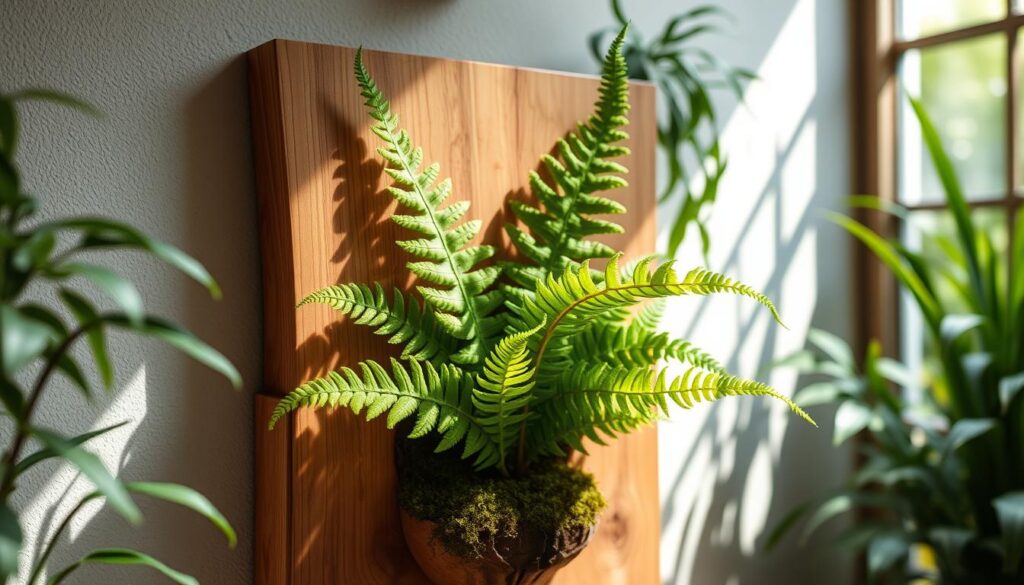
By knowing what staghorn ferns need and adjusting their care, gardeners can grow beautiful plants. These plants bring a touch of tropical beauty to any space, indoors or outdoors.
Watering Potted Staghorn Ferns
Watering potted staghorn ferns right is key to their health. These plants love moisture but need breaks to avoid root rot. It’s all about finding the right balance.
Frequency and Methods
Water your staghorn fern once a week in the growing season. In winter, cut back to every two to three weeks. Soak the whole plant in water or mist it well. This keeps the roots and fronds moist.
Signs of Over or Under-Watering
Watch your plant for signs of too much or too little water. Black fronds mean you’ve watered too much. Brown tips suggest it’s too dry. Adjust your watering based on what you see.
Getting staghorn fern watering right is crucial for their health. By watching for signs and sticking to a schedule, your fern will flourish.
Don’t forget to mist the fronds weekly to keep humidity up. With proper staghorn fern care and moisture, these plants will be a stunning addition to your space for years.
Fertilizing Staghorn Ferns
Proper fertilization is key for staghorn ferns to grow lush and healthy. Young plants need a balanced, water-soluble staghorn fern fertilizer every month. This gives them the staghorn fern nutrients they need to flourish.
As staghorn ferns get older, they need less fertilizer. They can get by with one or two feedings a year. Use a balanced 10:10:10 fertilizer ratio. Organic options like banana peels or worm castings can also help.
For mature staghorn ferns, dilute the fertilizer by half to avoid burning the leaves. You can also use granular time-release fertilizers on the sphagnum moss. In the fall and winter, when they grow slower, fertilize every other month.
“Proper fertilization is the key to maintaining lush, vibrant staghorn ferns in the home.”
Find the right mix of organic and synthetic fertilizers for the best results. Watch out for signs of too much fertilizer, like yellow leaves or wilting. With the right staghorn fern fertilizer and schedule, these plants will thrive for years.
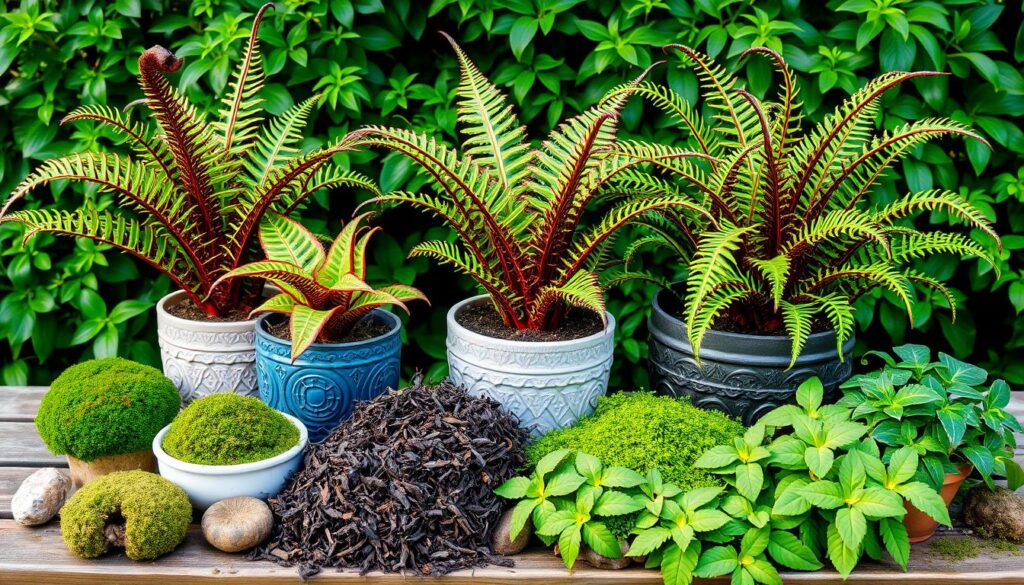
Other Staghorn Fern Species
While the Platycerium bifurcatum is well-known, there are many Platycerium varieties to discover. These other staghorn fern species have special traits and ways of growing. They attract those who love plants deeply.
Silver Staghorn Fern
The Platycerium veitchii, or silver staghorn fern, stands out with its blue-green fronds. It also handles sunlight better than many. Growing it can be tough, but its beauty makes it a favorite among plant lovers.
Stiff or Green Staghorn Fern
The Platycerium hillii, or stiff or green staghorn fern, has broad, bright green fronds. It grows more compactly, making it great for indoor spaces.
Even though Platycerium bifurcatum is the most famous, these other staghorn fern species let us see the variety in the Platycerium genus.
“The genus Platycerium has about 18 fern species. Each has its own special traits and needs for growing.”
Propagation Methods
Staghorn ferns are easy to grow and share. You can split them to make more plants. This way, you can grow more or give some to friends.
Division Techniques
Dividing staghorn ferns is simple and works well. You can split big plants into smaller ones. Each piece should have a shield frond and roots.
Plant these pieces in a mix of peat and compost. This mix helps them grow by keeping them moist and fed.
The division process takes time and patience. It might take months for new growth to show. But with care, these pieces will grow into strong plants.
| Propagation Method | Time to Establish | Success Rate |
|---|---|---|
| Staghorn Fern Division | 3-6 months | Moderate to High |
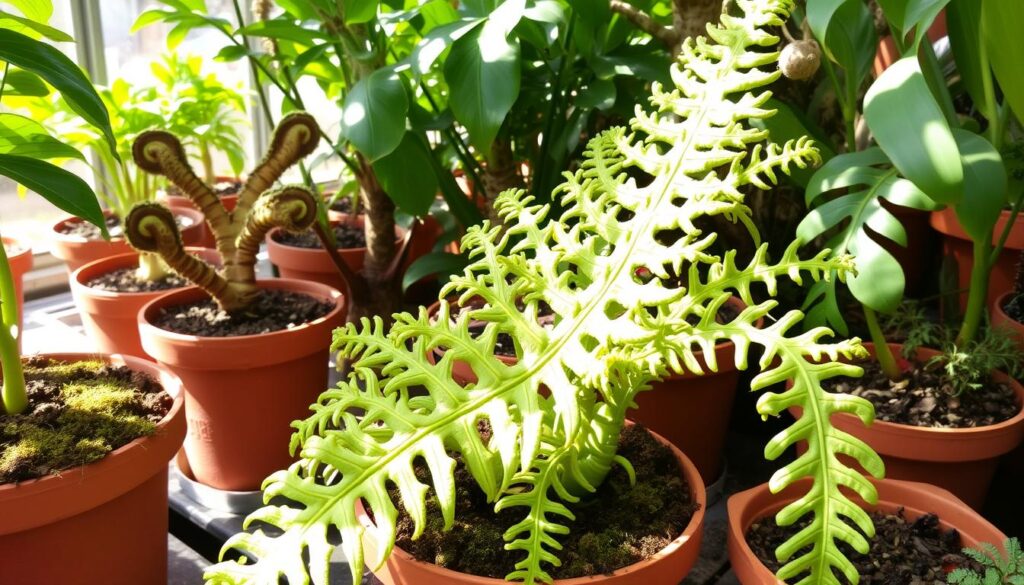
Staghorn ferns can also be grown from spores. This method is slower. Spores are on the underside of fronds in summer. They take up to six months to grow.
“Propagating staghorn ferns through division allows gardeners to expand their plant collections and share these unique specimens with others who appreciate their beauty and charm.”
Whether you use division or spores, growing staghorn ferns is rewarding. With patience and the right steps, you can enjoy these plants for years.
Pest and Disease Management
Staghorn ferns are usually tough and don’t get many pests or diseases. But, they can sometimes get common houseplant problems. Knowing about these issues and taking steps early can help keep your staghorn ferns happy and healthy.
Common Pests and Treatments
Staghorn ferns might get pests like spider mites, aphids, mealybugs, scale insects, and fungus gnats. You can fight these pests with natural sprays like neem oil or insecticidal soap. Checking your plants often and treating problems quickly is crucial.
Fungal Diseases and Prevention
Rhizoctonia fungus is a big problem for staghorn ferns, causing black spots. Keeping the right humidity and not overwatering helps prevent it. If you do get a fungal disease, using a natural fungicide can help fix it.
| Pest/Disease | Symptoms | Treatment |
|---|---|---|
| Spider Mites | Fine, silky webs; brown spots and tiny holes on leaves | Insecticidal soap, introduction of predatory mites |
| Scale Insects | Brown bumps or honeydew on fronds | Physical removal of affected leaves, horticultural oil, insecticidal soap |
| Fungus Gnats | Tiny black-winged pests hovering over the soil | Hydrogen peroxide solution, beneficial nematodes or predatory mites |
| Mealybugs | Cotton-like blobs on leaves and stems | Rubbing alcohol |
| Rhizoctonia Fungus | Black spots on fronds | Reduce watering, natural fungicide |
Using an integrated pest management (IPM) approach is best for staghorn ferns. This means using cultural, biological, and chemical methods together. Regular checks, keeping things clean, and using natural solutions are key to a healthy plant.
Potted Staghorn Fern Troubleshooting
Caring for a potted staghorn fern can be tricky. But, with careful observation and quick action, you can solve any problems. If the fronds at the base turn black, it’s usually because of too much water. On the other hand, if the tips of the fronds start to brown, it’s a sign that the plant needs more water.
Watching the shield fronds is key. It’s normal for the older ones to turn brown and dry up. But, if you see a brown, velvety material on the underside of the antler fronds, don’t worry. It’s a natural part of the plant’s life cycle.
By quickly spotting and fixing issues, you can keep your potted staghorn fern healthy. Pay attention to how much water it needs, the light it gets, and its overall look. Adjust things as needed to give your staghorn fern care the best chance to thrive.
Common Staghorn Fern Care Problems
- Blackening of fronds at the base: Often a sign of overwatering
- Browning tips of fronds: Indicates a need for more frequent watering
- Brown, velvety material on antler fronds: Natural reproductive structure, not a problem
- Older shield fronds turning brown and drying up: Normal and expected
By being alert and acting fast, you can keep your potted staghorn fern healthy for a long time. These plants need special care, but with the right approach, you can enjoy their beauty for years.
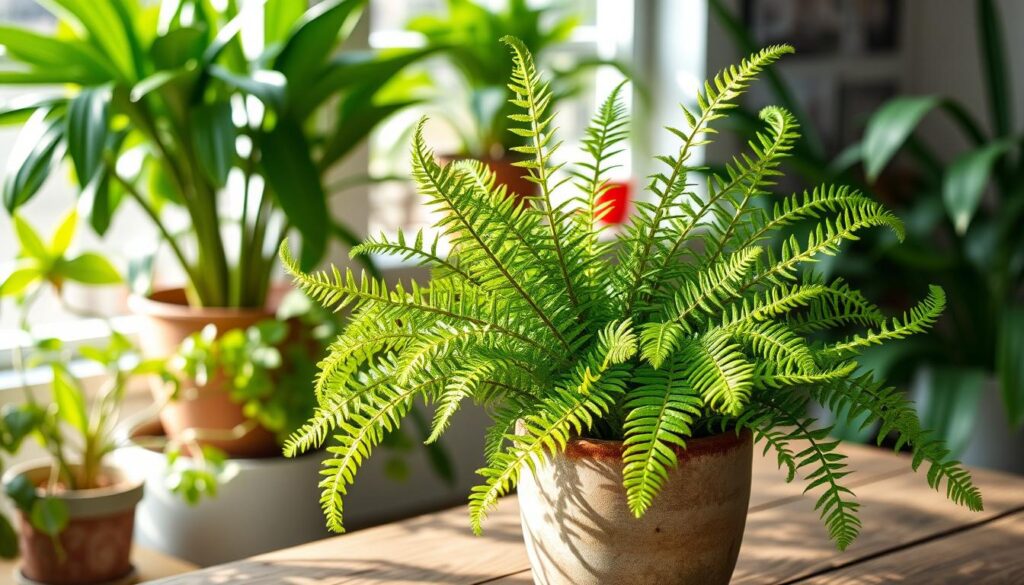
“Staghorn ferns are slow-growing, taking 10 to 20 years to fully mature, making them a true test of patience and dedication for plant enthusiasts.”
Staghorn Fern Growth Stages
Staghorn ferns have a unique growth process. They start small and grow into impressive plants. Knowing the growth stages helps gardeners care for their plants as they mature.
In the early stages, staghorn ferns have shield fronds for protection. As they grow, these fronds get bigger. The antler-like fronds also grow, making the plant look even more unique.
Staghorn ferns grow slowly, sometimes taking 20 years to reach full size. They may need a bigger mount as they grow.
| Growth Stage | Time to Maturity | Key Characteristics |
|---|---|---|
| Juvenile | 1-3 years | Small size, shield fronds developing |
| Transitional | 3-5 years | Larger shield fronds, antler fronds emerging |
| Mature | 10-20 years | Fully developed shield and antler fronds, impressive size |
Growing a potted staghorn fern requires patience and care. Understanding its growth stages helps ensure it thrives and reaches its full potential.
Conclusion
Staghorn ferns are truly captivating plants. They can do well indoors or outdoors with the right care. Knowing their needs, like bright, indirect light and high humidity, helps them thrive. You can grow a beautiful potted staghorn fern with the right techniques.
These plants need proper potting, mounting, fertilizing, and pest management. With these steps, they’ll reward you with their stunning, antler-like fronds for years.
If you’re new to staghorn fern care or already know your stuff, this guide is for you. It’s packed with tips to help you grow a stunning fern. Follow these best practices to enjoy the beauty of these remarkable plants.
Potted staghorn ferns are perfect for adding natural elegance to any space. Mastering their care lets you showcase these unique plants. Enjoy their enchanting presence for years to come.
